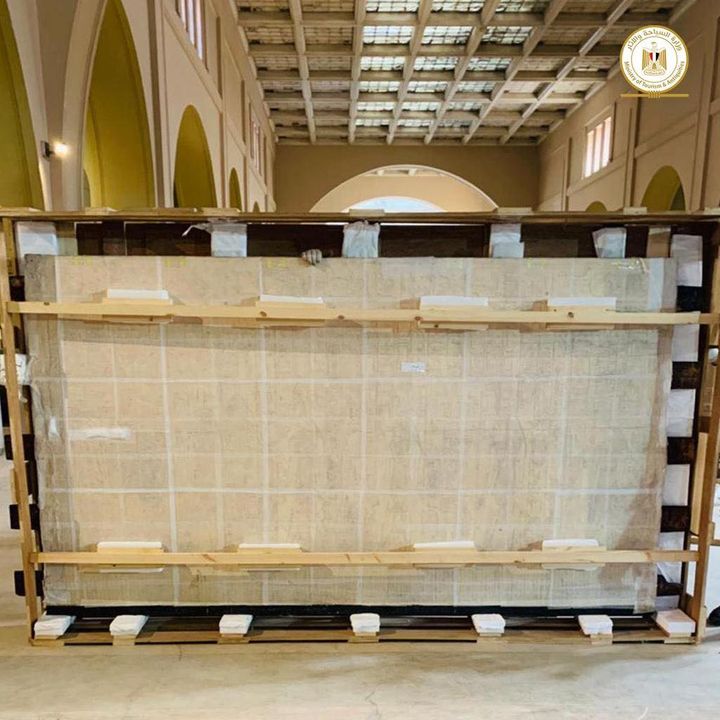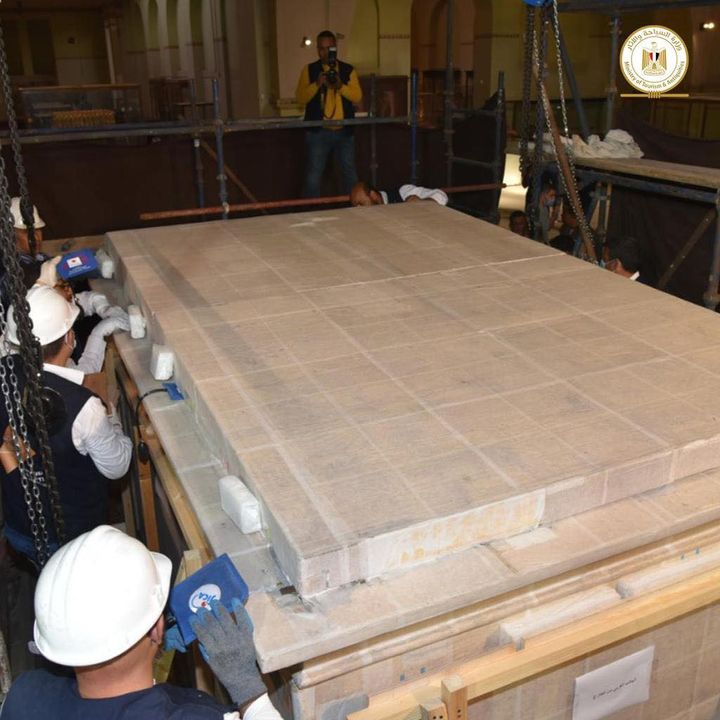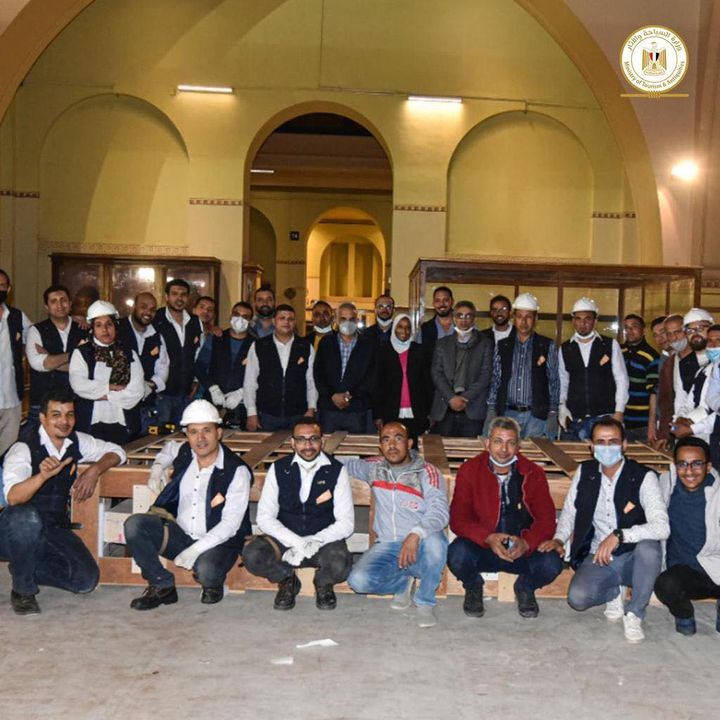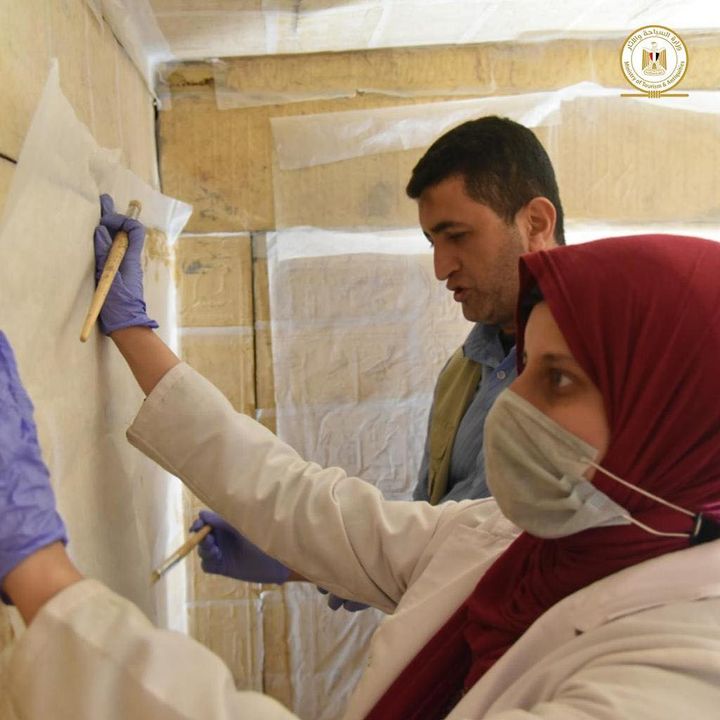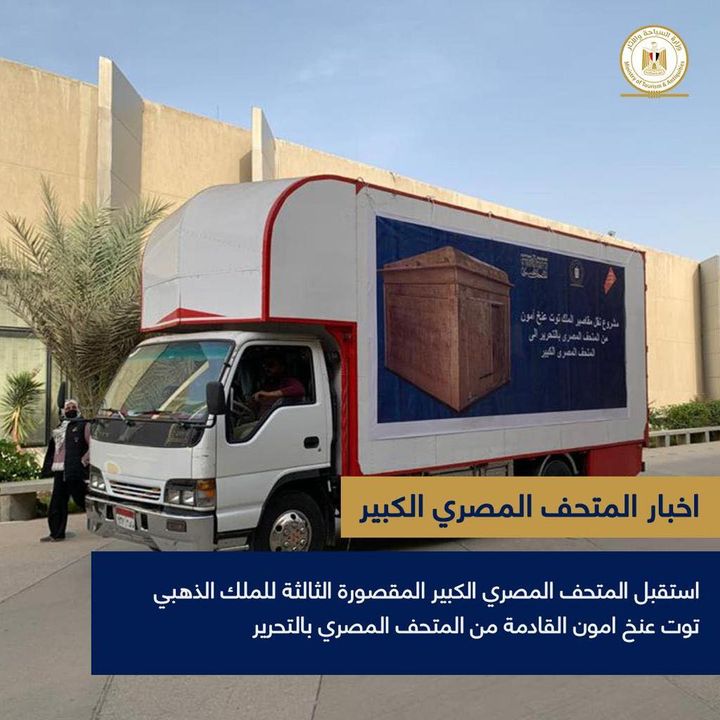بعد حوالي شهر من وصول المقصورة الرابعة والصغرى للملك توت عنخ آمون وتثبيتها بفاترينة العرض المخصصة لها بقاعات كنوز الملك الشاب بالمتحف المصري الكبير، استقبل المتحف المقصورة الثالثة للملك الذهبي قادمة من المتحف المصري بالتحرير، وذلك تمهيدا لعرضها ضمن سيناريو العرض المتحفي بالقاعات المخصصة لكنوزه.
وأوضح اللواء عاطف مفتاح المشرف العام على مشروع المتحف المصري الكبير والمنطقة المحيطة، أن عملية النقل تمت وسط إجراءات أمنية من قبل شرطة السياحة والآثار والنجدة، تحت إشراف مرممي وأمناء المتحف.
وقال الدكتور الطيب عباس مساعد وزير السياحة والآثار للشؤون الأثرية بالمتحف المصري الكبير، أن هذه المقصورة سوف تخضع لأعمال الترميم داخل المتحف. وهي مصنوعة من الخشب المذهب، وقد تم العثور عليها ضمن مقتنيات الملك بمقبرته بالبر الغربي بالأقصر؛ والتي تم الكشف عنها في نوفمبر 1922، ثم تم نقلها مع باقي القطع إلى المتحف المصري بالتحرير حيث تم عرضها.
وأضاف د. الطيب عباس أنه سيتم نقل باقي المقاصير تباعا لتعرض جميعا وفقا لأحدث طرق العرض المتحفي بالقاعات المخصصة لعرض كنوز الملك والتي تبلغ مساحتها حوالي 7200 متر مربع والمزودة بأحدث وسائل العرض المتحفي من فتارين ذات تحكم بيئي في درجات الحرارة والرطوبة والإضاءة، بالإضافة إلى وسائل توضيحية من الجرافيك وبطاقات شرح خاصة بكل قطعة، وكذلك شاشات عرض توضح سيناريو العرض الخاص بالملك توت عنخ آمون.
كما أكد الأستاذ مؤمن عثمان رئيس قطاع المتاحف، على أن عملية نقل المقصورة تمت طبقا للأسس والمعايير العلمية الدقيقة حيث تم فك المقصورة إلى 10 أجزاء بنفس تكنيك الصناعة الذي استخدمه المصري القديم، ثم تغليف كل جزء على حدة داخل صندوق داخلي وآخر خارجي باستخدام مواد خالية من الحموضة.
وأشار إلى أن فريق العمل من المتحف المصري الكبير ومتحف التحرير سوف يقوم بتجميع المقصورة مرة أخرى خلال الأيام القليلة القادمة داخل الفاترينة المخصصة لها داخل قاعات كنوز الملك الشاب.
ومن جانبه قال دكتور عيسى زيدان مدير عام الشئون التنفيذية للترميم ونقل الآثار بالمتحف المصري الكبير، انه قبل عملية النقل تم فحص المقصورة وعمل تقرير مفصل لها لإثبات حالة حفظها بصورة دقيقة، كما قام فريق المرممين بأعمال التوثيق العلمي والأثري لها بإستخدام أحدث أنواع كاميرات التصوير الفوتوغرافي والفيديو والتصوير بتقنية I R، وكذلك الفحص باستخدام جهاز X R F ، وجهاز X Ray Radio Graphy، وذلك للتعرف على أماكن الألسن المعدنية والخشبية وأماكن التعشيق للمقصورة؛ الأمر الذي من شأنه ساعد وبشكل دقيق فريق العمل على وضع خطة فك المقصورة بأمان وبطريقة علمية.
وأضاف أن فريق العمل قام بتغطية المقصورة بورق التشو الياباني ومواد التقوية المناسبة التي تضمن سلامتها أثناء عملية النقل.
وأوضحت الأستاذة صباح عبد الرازق مدير عام المتحف المصري بالتحرير، أن طول المقصورة الثالثة يبلغ 3.40م ، العرض 1.92م، والأرتفاع 2.15م، وتزن حوالي 1142 كليو جرام وتنتهي الجدران من أعلى بإفريز، لها باب مزدوج مغلق بختم ملكى.
وتتكون المقصورة من سقف مزين بقرص شمس مجنح وثمانية طيور موضوعه تحتها ألقاب الملك، كما يوجد على السقف من الداخل نقوش، كذلك تحوي المقصورة بوابه عليها نقوش ونصوص من كتاب الموتى ومزينه من الداخل. وفي أعلى الباب قرص الشمس مجنح محاط من جهة اليمين وجهة اليسار بمجموعة من العلامات.
واضافت انه على ضلفتى الباب يوجد مثلت ايزيس ونفتيس، وعلى اليسار واليمين مثلت المعبودات الحامية نوت، امستى، انوبيس، دوا موت اف، وحورس المنتقم لأبيه، وعلى الجانب، حابي، انوبيس، قبح سنو اف، جب ونوت على الناحية الأخرى. وعلى اللوحة الخلفية نقشين لايزيس ونفتيس.
وتتضمن المقصورة كذلك على جوانب مزينة بنقوش من كتاب الايمي دوات ويحتوي الجزء الخلفى لها مناظر منقوشة من كتاب الموتى.
The Grand Egyptian Museum receives the third shrine of Tutankhamun
A month after receiving and placing the fourth shrine of King Tutankhamun in its display case in the hall dedicated the Boy King’s treasures in the Grand Egyptian Museum, the museum received the third shrine of Toutankhamun. The Shrine arrived from the Egyptian Museum in Tahrir, in preparation for displaying it within the museum display scenario in the halls of Toutankhamun.
Major General Atef Miftah, General Supervisor of the Grand Egyptian Museum and the surrounding area, explained that the transfer was carried out amid security measures by the Tourism and Antiquities Police, under the supervision of the restorer and museum curators.
Dr. Al-Tayeb Abbas, Assistant Minister of Tourism and Antiquities for Archaeological Affairs at the Grand Egyptian Museum, said that this shrine will undergo restoration work inside the museum. He added that It is made of gilded wood, and was discovered among the treasures of the king in his tomb in Luxor’s West Bank in November 1922. He explained that it was transferred with the rest of the artifacts to the Egyptian Museum in Tahrir, where they were displayed.
Dr. Tayeb Abbas added that the remaining shrines will be transferred successively, to be displayed according to the set display scenario in the halls dedicated to the king’s treasure. He said that the halls have an area of about 7200 square meters and are equipped with the state of the art museum display, with environmental control of temperature, humidity, and lighting, in addition to labels with graphics and cards for each piece.
Professor Moamen Othman, head of the museums sector, confirmed that the transfer of the cabin was carried out according to the principles and accurate scientific standards. He added that the shrine was dismantled into 10 parts with the same manufacturing technique that the ancient Egyptian used, then each part was individually wrapped inside an inner box and another external using acidic free materials.
He pointed out that the team from the Grand Egyptian Museum and the Tahrir Museum will assemble the shrine again within the next few days inside the vanity allocated for it inside the halls of the young king’s treasures.
For his part, Dr. Issa Zidan, Director General of Executive Affairs for Restoration and Transfer of Antiquities at the Grand Egyptian Museum, said that before the transfer, the shrine was examined and a detailed report was made to document its preservation status in an accurate manner, and the restorers team carried out scientific and archaeological documentation of it using the latest types of photographic and video cameras. IR imaging, as well as XRF scanning and X Ray Radiography were done to identify the locations of the metal and wood tongues and the docks of the shrine. He said that this helps the working team to accurately develop a plan to dismantle the shrine safely and scientifically.
Ms. Sabah Abdel Razek, Director General of the Egyptian Museum in Tahrir, explained that the length of the third shrine is 3.40 m, the width is 1.92 m, and the height is 2.15 m. It weighs about 1142 kg. The walls end at the top with a frieze. It has a double door closed with a royal seal.
The shrine consists of a ceiling decorated with a winged sun disk and eight birds with the titles of the king placed under it, and on the inside there are inscriptions on the ceiling. In addition to that the shrine contains a gate with inscriptions and texts from the Book of the Dead and decorated on the inside. And at the top of the door is a winged sun disk surrounded on the right and left side by a group of signs.
The shrine also includes sides decorated with inscriptions from the Book of the Emmy Duat, and the back contains engraved scenes from the Book of the Dead.
Ministry of Tourism and Antiquities وزارة السياحة والآثار

